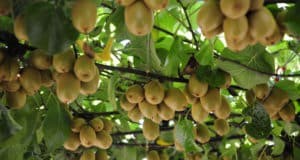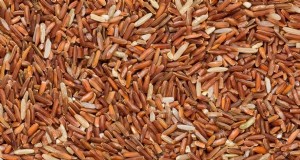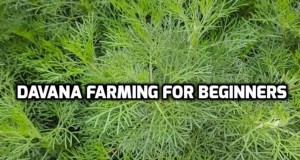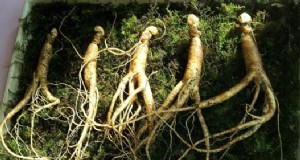スパイスファーミングの紹介:
スパイスファーミング:スパイスは、風味を目的として食品に使用される物質です。 色または保存。種子など、植物や木のさまざまな部分からさまざまなスパイスが得られます。 樹皮、 根と果実。いくつかの香辛料は、抗菌性と抗菌性を持っていると期待されています。いくつかのスパイスの使用は化粧品に見られます、 宗教的な儀式、 薬や香水。さまざまなスパイスが世界のさまざまな国から生まれたと考えられています。シナモンと黒胡椒は南アジアと中東に由来し、 メソポタミア文明中のクローブ、 東南アジアのバンダ諸島のナツメグ。スパイスの需要は中世のヨーロッパで最も高かった。この期間中に、スパイスはアジアとアフリカから輸入されました。現代では、インドのコショウ市場に対する高い需要がありました。最近のスパイスの主な問題は希釈です。混ぜ物(他の不要な製品を元の混合物に混ぜる)のために、スパイスの品質が低下しました。
さまざまな形のスパイスが新鮮です、 乾燥して粉末。スパイスは一般に、より長い使いやすさとより長い貯蔵寿命のために乾燥した形で入手できます。生姜などの乾燥したものよりも新鮮なものを使用すると、より多くのエッセンスを与えるいくつかのスパイスがあります。ウコンのようなスパイスは常に粉末の形で使用されます。フェンネルやマスタードのようなスパイスは、全体または粉末の両方で使用されます。香辛料の風味は、酸化や蒸発により空気に触れると失われます。そう、 スパイスは、最高の風味を体験するために、必要に応じて全体として保管し、粉砕することを強くお勧めします。調理に使用する香辛料は、調理の早い段階で添加されるため、調理の最後に添加されるハーブとは異なり、風味が食品に注入されます。
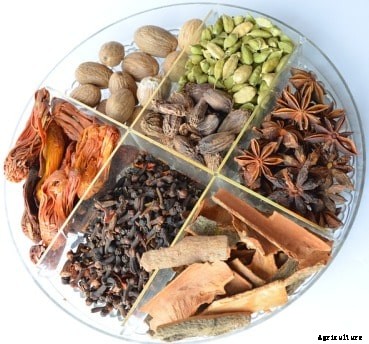 スパイスの栽培慣行。
スパイスの栽培慣行。
スパイスにはカロリーが含まれていると予想されますが、 脂肪の一部、 炭水化物、 ミネラル、 微量栄養素とタンパク質。クミンとショウガは高い抗酸化作用を示し、天然の防腐剤として役立ちます。
スパイスはサルモネラと呼ばれる細菌によって汚染されています。これらの細菌のいくつかは抗生物質に耐性があり、現在は放射線滅菌法を使用して治療されています。
ウコンスパイス農業:
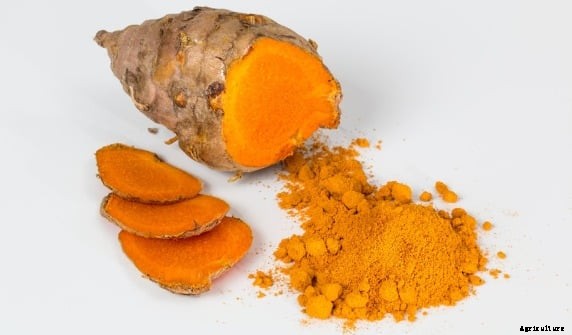 ターメリック。
ターメリック。 - 前書き: ウコンの二名法はクルクマロンガで、ショウガ科に属しています。インド亜大陸の原住民と考えられています。これは、乾燥粉末の形で使用される根茎です。薬効があるので抗菌作用があります。黄色で香りもいいです。
- ウコンスパイス農業のための土壌と気候条件: ウコンの栽培には、腐植土が多く、水はけのよい砂質・粘土質ローム土壌が使用されています。それは海面またはで栽培されています 1500メートルの標高 海抜。この地域の気温は次のように推定されています 摂氏20〜30度 と平均 降雨量は約1500〜2250mmである必要があります
- 伝搬: ウコンは、冬の終わりに植えられる根茎の挿し木を通して繁殖します。
- 土地の準備と植栽: 深さ3インチのピットは、ハンドホーと 行間隔は25cmx 30cmです 。これらは土と乾いた牛糞で覆われています。尾根と畝間は 行間の距離45〜60 cm 植物の間隔は25cmです。
- 肥料と灌漑: 40トン/ヘクタールの牛糞はターメリック農業に広く使用されています。この植物は灌漑タイプなので、 必要です 重い土壌の場合は15〜20サイクル、軽い土壌の場合は35〜40サイクル。 FYM @ 10トン/ ha 基礎ドレッシングに必要です。配給 Nの:P:Kは125:37:37kg / haです。
- マルチングはサトウキビのゴミまたは緑で2回行われます 50日間隔で@ 12-15トン/ haを残します。
- 疾病管理: シュートボーラーはによって制御されます 0.1%マラチオンを噴霧 。根茎のスケールは、植える前に根茎をキナルフォス0.1%に浸すことによって制御されます。根茎の腐敗は、を使用して制御されます ジタンM-450.3% 土壌の準備中。葉のしみはによって制御されます 0.2%ジタンM-45を噴霧 。
- 収穫と処理: 収穫は、植え付けから10か月後、根茎が成熟したときに行われます。暖かい天気はターメリックに良いです、 したがって、10月に播種された場合、8月に収穫されます。根茎は柔らかくなるまで茹で、竹マットの上に広げて天日で約15日間乾燥させます。
- 収率: 平均して1エーカーの土地は8-10トンのターメリックを産出します。
月桂樹の葉のスパイス農業:
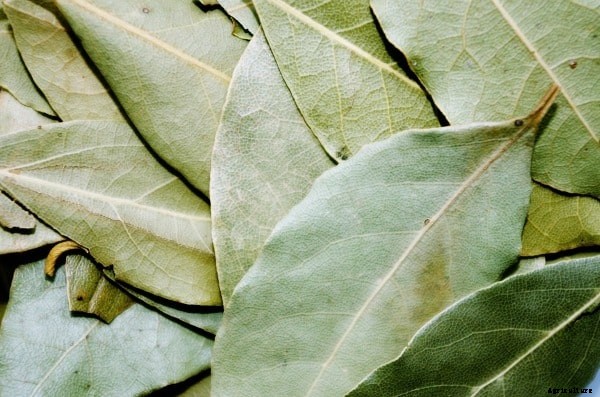 月桂樹の葉。
月桂樹の葉。 - 前書き: 月桂樹の葉(二名法:Laurus nobilis)。それは地中海で始まり、40フィートの高さに成長します。植物は中型の緑の葉を持っています。香料としてだけでなく、薬としても使用されています。
- 月桂樹の葉のスパイス農業のための土壌と気候条件: 日光は必須であり、冷たい風や霜は有害な場合があります。好ましい気候は暖かく湿った地中海性気候です。十分な有機物を含む水はけの良い土壌は、 6-8のpH範囲。
- 伝搬: 月桂樹の葉の繁殖には、層状の新芽または根の挿し木が使用されます。
- 土地の準備と植栽: 土地は農場の肥料で補われ、雑草は耕作によって取り除かれます。
- 肥料と灌漑: 腐った農場の肥料は、土壌の豊かさを高めるのに役立ちます。点滴灌漑により、土壌水分を損なわないように十分な水が供給されます。
- 疾病管理: ダニ、 アブラムシと硬い鱗は木に感染する害虫であり、ニームオイルの塗布によって防除されます。硫黄スプレーは、黒い斑点や葉の損傷を防ぎます。
- 収穫と処理: 常緑樹なので、 葉は一年中収穫できます。通常、使用前は乾燥しています。
- 収率: 1ヘクタールの土地は6トンの葉を生産します。
ナツメグとメイススパイスの栽培:
- 前書き: ナツメグとメイスは同じ木の産物です(植物名:Myristica fragrans houtt)。この木はインドネシア原産で、現在インドの一部で栽培されています。葉が密集し、高さ20mまで成長する常緑樹です。これらのスパイスは食品の香料に使用され、 香水、 油とバターの準備。
- ナツメグスパイス農業の土壌および気候条件: 暖かい、 年間降水量のある湿潤気候 150cmの これらの木にはが必要です。理想的なエリアは海面からです 1300メートルまで 海抜。ガーツ山脈西部と東部の斜面は、ナツメグとメイスの農業に適しています。粘土で土、 ローム、 この木には砂と赤いラテライトが適しています。
- 伝搬: この木の実の種は繁殖に使われます。空気の層化と出芽も繁殖のための成功した方法です、 しかし、テクニック 「上胚軸接ぎ木」の 最も生産的です。
- 土地の準備と植栽: 苗が育つとき、 後 12〜18か月 それらはメインエリアに移植されます。寸法60cmの立方体の穴が掘られ、表土と堆肥で満たされています。ピット間の間隔は 8 m x 8 m 。植栽は梅雨の時期に行われます。初期には日陰が必要です。マルチングは、周囲にあるゴミを使って行われます。
- 肥料と灌漑: 木はより高い収量と成長のために大量の肥料を必要とします。初年度はFYM @ 10kg /プラントを使用。樹齢15年の樹木には、約50kgの肥料が必要です。 窒素@ 20グラム、 リン@ 18グラムとカリ@ 50グラム 初年度は各工場に適用されます。線量は木の年齢とともに増加し、年に2回適用されます。 5月から6月と9月から10月。灌漑はそれほど必要ありません。
- 疾病管理: diplodianatalensisによって引き起こされるダイバックは、枝の端にボルドー混合物を適用することによって制御されます。糸の光はMarasmiussp。によって引き起こされます。 1%のボルドー混合物を噴霧することによって制御されます。果実の腐敗は、噴霧によって制御されるPhytophthoraとDiplodianatalensisによって引き起こされます ボルドーの1%
- 収穫と処理: 苗木を使用する場合、ベアリングは7〜8年で始まります。 しかし、接ぎ木が行われる場合、ベアリングは4-5年で始まります。完全なベアリングは15〜20年後に達成され、最大60年の降伏があります。収穫は6月から8月まで行われます。果実の熟成は、肉質の皮が裂けて開くときに知られています。メイスはナッツから分離され、10〜15日間太陽の下でゆっくりと乾燥されます。種子はまた、太陽の下で、または人工的なプロセスによって、4〜8週間別々に乾燥されます。外殻を外してナットを外します。
- 収率: 一本の木の平均的な生産量は、年間2000〜3000本です。 1ヘクタールの土地で800kgのナツメグと100kgのメイスを生産できると予想されています。
スターアニススパイスファーミング:
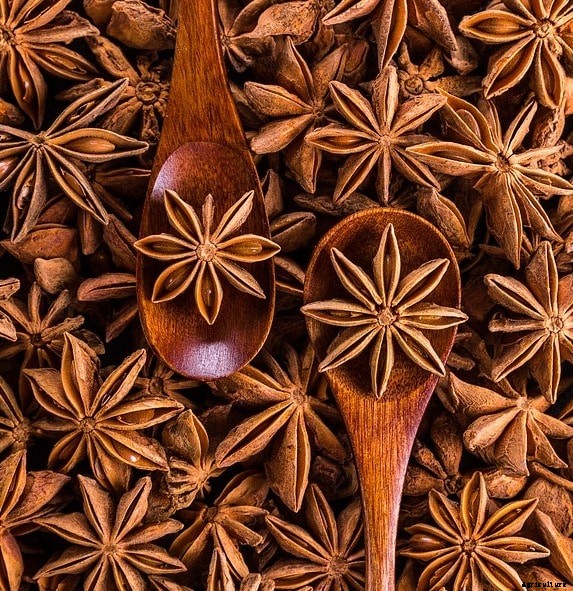 スターアニス。
スターアニス。 - 前書き: このスパイスは形からその名前が付けられています。その植物名はIlliciumverumです。シベリアはアニス栽培に理想的であると考えられています。香りの強いダークブラウンのスパイスです。これはアニスとも呼ばれ、薬効があります。常緑樹で、高さ5〜10mに成長します。
- スターアニススパイス農業のための土壌と気候条件: アニス栽培には、腐植土が豊富な土壌または弱酸性土壌が最適です。気温が摂氏-10度以上の亜熱帯気候が必要です。植物は、乾燥した風や冷たい風がない、暖かく晴れた気候を必要とします。土壌のpHは6-6.7です。
- 伝搬: 繁殖は、種や挿し木を直接播種することによって行われます。繁殖のための温度は摂氏18-20度です。
- 土地の準備と植栽: 6週齢の苗を間隔を空けて播種します 12インチ 。各行は分離されています 18〜24インチ 。植え付けは春に行われます。
- 肥料と灌漑: 十分な水分を維持するだけで十分です。冬にはほとんど灌漑が必要ありません。木の周りに3インチの堆肥の層を広げることは最高の肥料です。時にはより高い収量と品質のために合成 NPK肥料またはバクトフィルB-10とスラボール (バイオ肥料)を使用しています。
- 疾病管理: 抗菌・害虫忌避剤なので、 したがって、これらの植物の病気を管理するのにそれほど多くは必要ありません。
- 収穫と処理: 種子から育てられた木は実を結ぶのに6年かかります。果実は熟したときに拾い上げられ、緑色から赤褐色に色が変わるまで天日で乾燥されます。
- 収率: 良好な条件下では、この木の平均果実収量は1551 kg / haです。
より大きなカルダモンスパイス農業:
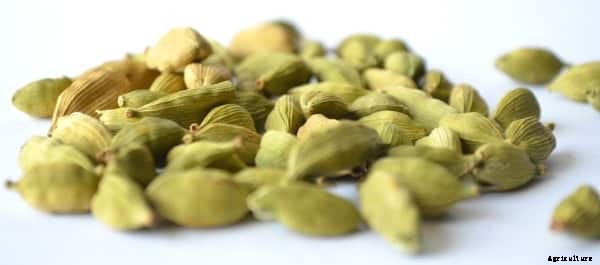 カルダモン。
カルダモン。 - 前書き: これはブラックカルダモンとも呼ばれ、その二名法の名前はAmomumsubulatumです。さやはスモーキーな香りが強く、スパイスとして使われています。最大の農産物はネパールからです。また、黄疸の治療などの薬用用途もあります。
- 土壌と気候条件: このスパイスはの成長した標高です 1000-2000 平均海抜より上。年間平均降雨量は 3000〜3500 mm 。深い、 水はけのよいローム質の土壌は、これらの植物に適しています。土壌のpHを維持する必要があります 4.5-6で。
- 伝搬: この植物の繁殖は、根茎または種子によって栄養的に行われます。成長した植物からの根茎は、より小さな塊に取られて処理され、ピットに植えられます。
- 土地の準備と植栽: この植物の農業のための適度な傾斜が考慮されます。寸法の穴 30 x 30 x 30 cm の間隔で掘られています 5 x 1.5 m モンスーン期間中の各ピット間。ピットは表土と堆肥で覆われています。ピットの中央に苗を植え、根元の乾燥した葉でマルチングを行います。
- 肥料と灌漑: 牛糞および糞尿として使用される非食用油粕。より良い灌漑はより高い収量をもたらします。必要に応じてスプリンクラー灌漑が使用されます。
- 疾病管理: この植物では、真菌や細菌の病気が発生する可能性があります。この植物に対する2つの主要な脅威は、ChirkeとFoorkeyです。
- 収穫と処理: カプセルの種が茶色に変わったら、 耕うん機は30-35cmにカットされ、 10〜15以上 収穫は「 Elaichichurri ’ スパイクが山積みになっています。カプセルを分離して乾燥させます。萼は、カプセルをワイヤーでこすることによって除去されます。
- 収率: 推定によると、1エーカーの土地で2000kgの乾燥カルダモンが生成されます。
少ないカルダモンスパイス農業:
- 前書き: このスパイスはインド亜大陸の原産であり、リスト全体で最も必要なスパイスです。西ガーツ山脈に見られる常緑植物です。このスパイスの二名法はElettariaCardamomum Lです。この植物の最大の高さは2〜4メートルで、インドで見つかった品種はMysoreです。 マラバールとvazhukkaタイプ。
- カルダモンスパイス農業の土壌および気候条件: カルダモンの少ないスパイス栽培に必要な最適な温度と降雨量は次のとおりです。 摂氏10〜35度 と 1500〜4000 mm それぞれ年間降水量。このスパイスの栽培には、特に森林地帯に腐植土が豊富な黒いローム質の土壌が最適です。砂質土は全く好ましくありません。
- 伝搬: 繁殖には種子または吸盤が使用されます。これらの種子は苗床で育てられ、適切な条件でメインエリアに植えられます。
- 土地の準備と植栽: 45cm x 45cm x30cmのピット 4月から5月に掘られ、堆肥と表土で満たされます。植栽は、間隔を空けて斜面の等高線に沿って行われます。 2 m x 1 m 。モンスーンの始まりはこれらの種を植えるのに理想的であり、それらは夏にメインエリアに間隔を置いて移植されます 20cm x 20cm 。シェードが提供され、水が定期的に供給されます。
- 肥料と灌漑: 窒素@ 90グラム、 ベッドサイズが5m x 1 mの場合、リン@ 60グラムとカリ@ 120グラムが必要です。 この用量は、それぞれ45日間隔で3回に分けて供給されます。この作物に使用されている肥料の含有量は 窒素@ 75 kg、 1ヘクタールあたりリン@ 75kgおよびカリ@ 150 kg 外部から灌漑されている場合は、 しかし、畑が雨で灌漑されている場合、使用される肥料の比率は30:60:30 kg / haです。全肥料は分割して施肥し、5月と9月の2回施肥します。植物の周囲30cmに肥料を施します。穂形成中は灌注が非常に必要ですが、 開花と果実の形成。モンスーン灌漑の到着が次の間隔で行われるまで 10〜15日。
- 疾病管理: アザミウマとシュートボーラーは、モノクロトホス0.025%を噴霧することによって制御されます(3月から9月)。アブラムシは、0.05%のジメトエートを噴霧することによって防除されます。寄生性線虫は、植物をカルボフラン3g @ 5kg a.i / haで処理することによって防除されます。蒴果の腐敗は噴霧によって制御されます 1%ボルドー 根茎の腐敗は、土壌を次のように処理することによって制御されます 0.2%のオキシ塩化銅 。
- 収穫と処理: 植え付けから2年が経ち、実をつけ始めます。収穫は10月から11月の間に行われます。収穫された果実は、電気乾燥機を使用して、 45〜50度 約 14〜18時間 。
- 収率: 1ヘクタールの土地で1300kgの乾燥カルダモンが生産されると推定されています。
コリアンダースパイス農業:
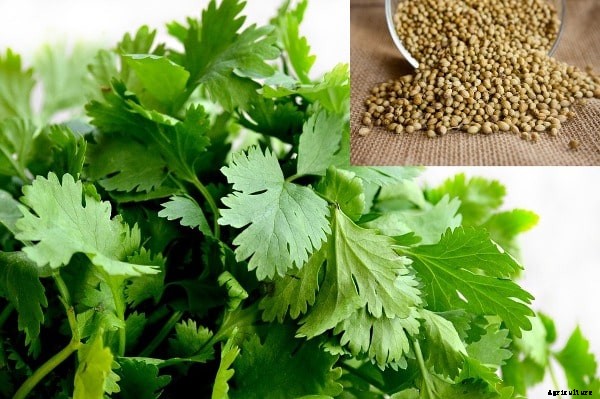 コリアンダー。
コリアンダー。 - 前書き: 地中海地方に自生するハーブです。インドでは、いくつかの州がコリアンダー農業を行っています。 ただし、ほとんどの場合、エクスポートではなくローカルで使用します。他の国への輸出はほとんどありません。この植物の二名法の名前はCoriandrumSativumLです。その味と香りのために最も望ましいです。植物の葉とドライフルーツの両方が食品の準備に使用されます。これらのハーブ植物は30-70cmの高さに成長します。薬効もあります。
- コリアンダースパイス農業の土壌および気候条件: この植物は一年中栽培に適しており、熱帯の品種です。有機物が豊富なすべての土壌タイプがその栽培に適しています。十分な降雨量がある場合は、黒い綿の土壌が最適であると考えられています。
- 伝搬: 伝播はシードを介して行われます。
- 土地の準備と植栽: モンスーンの開始後、土地は3〜4回耕作され、ラビ作物であるため、10月と11月に種まきが行われます。 1ヘクタールの土地が必要 10〜15 kg 種子の。より良い発芽技術は、種子を水に浸すことです。 12〜24時間 播種する前に。ファーム内の行は、次の間隔で区切られます。 30〜40cm 最大奥行きは3cmです。
- 肥料と灌漑 : FYM @ 10トン/ haが使用されます。 NPK肥料@ 15 kg、 1ヘクタールあたり40kgと20kg それぞれ、 灌漑作物には必要です、 一方、天水作物の場合 NPK @ 20kg、 30kg、 1ヘクタールあたり20kg それぞれが必要です。農業全体で4〜6サイクルの灌漑が必要です。各灌漑サイクルは30〜35日の間隔で行われます。
- 疾病管理: アブラムシはによって制御されます 0.3%のマラチオンを散布するのに対し、キネリムシは20〜25 kg / haのエンドスルファンの4%の粉塵を使用して防除されます。 うどんこ病や萎凋病は、湿った硫黄を噴霧することで防除されます。茎のこぶは制御されます 0.1%のバビスチンを使用し、枯れは0.2%のマンコゼブを使用して制御されます。
- 収穫と処理: 一般的に作物は内で収穫されます 90〜110日 。果実の色が緑から茶色に変化することは、収穫時期を示しています。
- 収率: 天水作物の収量は400-500kg / haであり、灌漑作物の収量は600-1200 kg / haです。
フェヌグリークスパイス農業:
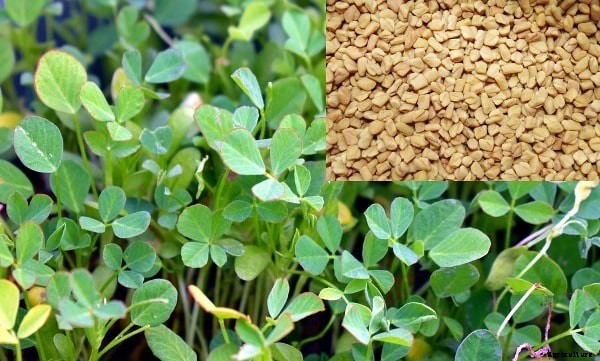 フェヌグリーク。
フェヌグリーク。 - 前書き: このハーブは東ヨーロッパと西アジアに自生しています。葉と種は食品の調理に使用されます。その二名法の名前はTrigonellaFoenum-graecumLです。作物の最大の高さは0.9mです。 T. Foenum-graecum(methi)と corniculata(かすりメチ)。
- フェヌグリークスパイス農業の土壌および気候条件: Both temperate and tropical climate are suitable for its cultivation. During seed germination temperature is being maintained around 8-27 degree Celsius. It can resist frost and extreme cold climate. Very low rainfall is required for this crop. Clayey loam is extremely good for these crops with a pH of 6-7
- PROPAGATION: Propagation is done by seeds. Seeds are soaked in warm water for 6-12 hours before sowing.
- LAND PREPARATION AND PLANTING: Ploughing is done thrice before sowing seeds and the soil beds are created uniformly with spacing between rows as 20-25 cm 。 In the plain area September to November is usually preferred for sowing the seeds, whereas in hilly areas the sowing is done in March.
- MANURING AND IRRIGATION: FYM @15 tonnes per hectare 使用されている。 NPK fertilizers @25 kg, 25 kg, 50 kg/ha respectively is required. Nitrogen is applied in two installments whereas the other two types of fertilizers are applied to the base of the crops at a time. 4-6 irrigation cycles are required during entire crop growth with an interval of 20-25 days between each cycle. Pre-irrigation is also done.
- DISEASE MANAGEMENT: root rot is caused by Rhizoctoni Solani and is controlled by drenching the soil with carbendazim 0.05%. Powdery mildew is controlled by spraying dinocap @20-25 grams/10 liters of water 。 Downy mildew is controlled by spraying 0.2% of difoltan solution.
- HARVESTING AND PROCESSING: Young shoots are removed within 25-30 days of sowing. The leaves are cut within 15 days of growth and minimum 2 cuttings are done before the flowering and fruit formation of the crop. The crops are removed when the pods dry and the entire thing is dried in the sun, which facilitates the removal of seeds by rubbing with the hands. Again the removed seeds are dried in the sun and packed.
- YIELD: One hectare of land produces 1200-1500 kg of seeds and 800-1000 kg of leaves.
ROSEMARY SPICE FARMING:
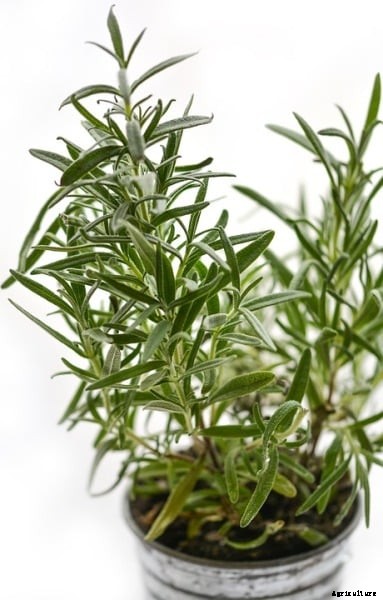 Rosemary.
Rosemary. - INTRODUCTION: Rosemary is a perennial herb and is evergreen in nature. It is a native of the Mediterranean region and its binomial name is Rosmarinus officinalis. The shrub has a maximum height of 1.5m. This crop is famous for its aroma; the leaves, twigs and flowers are used for various purposes.
- SOIL AND CLIMATE CONDITIONS FOR ROSEMARY SPICE FARMING: Well-drained lateritic soil is best for the cultivation of rosemary crops. The pH of the soil is maintained in-between 5.5-7. 20-30 degree Celsius is the ideal temperature for its growth. Average annual rainfall of 10-20 cm is required a nd an altitude of 2500 m above sea level is considered good for growing rosemary.
- PROPAGATION: Seeds are used for growing rosemary plants, but with extreme care and typical conditions. Also cuttings, roots and layering are sometimes used to grow rosemary.
- LAND PREPARATION AND PLANTING: Land to be used for cultivation is ploughed two times and neem care is mixed as a source of manure. The spacing between rows of rosemary plants have to be 40-50 cm and beds of width 1-2 m is created. Initially the cuttings are raised in the nursery and then shifted to main area during midsummer.
- MANURING AND IRRIGATION: FYM @ 50 tonnes/ha, neem cake@1 ton/ha, natural compost@ 5 tonnes/ha and vermicompost @5 tonnes /ha as applied at the base of the crop during initial planting. Subsequent year onwards 5-30 kg per hectare is applied.
- DISEASE MANAGEMENT: This shrub is resistant to pests and fungus.
- HARVESTING AND PROCESSING: When the flowering starts the plants can be harvested. From second year harvesting is done every four months. The leaves are cleaned thoroughly and dried in shade for 10-15 days 。
- YIELD: one hectare of land annually produces 2.5 tonnes of dried leaves of rosemary.
CHILLIE SPICE FARMING:
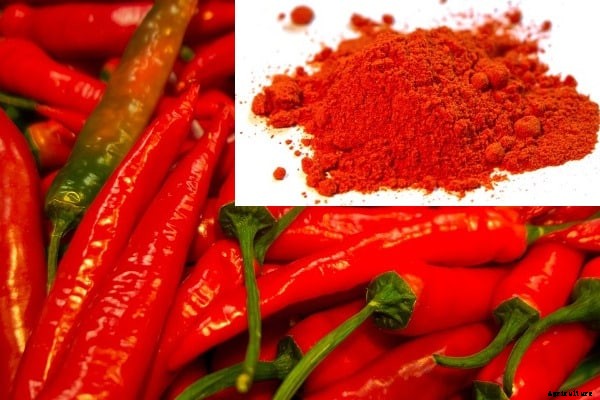 Chilli spice.
Chilli spice. - INTRODUCTION: very common and needed Indian spice is chilli. It originated from Mexico, but the largest producer of chillies Japan. It is both a spice and a vegetable variety. The binomial name of the chili is capsicum annuum. It is a shrub
- SOIL AND CLIMATE CONDITIONS FOR CHILLIE SPICE FARMING: It needs warm, humid and dry weather. Temperature ranges from 20-25 degree Celsius 。 Temperatures beyond 35 degree effect the fruit development. Very little moisture is required to grow chillies. Well-drained sandy loam soil having high organic content is useful for growing chillies. The pH of the soil should be in-between 5-7.5. 2100 meters above mean sea level is the altitude up to which chillies can be grown.
- PROPAGATION: chilli propagates through seeds.
- LAND PREPARATION AND PLANTING: 2-3 ploughings are given to the soil before sowing seeds. Before sowing the soil is sterilized to make it free from fungus and other infections. Seeds are initially planted in nurseries and then transplanted to the main area. Coco peat is used to cover the soil with seeds and is lightly watered until seedling stage. The crop distance is 45 cm x 45 cm in the main area. Ridges and furrows of dimensions 60 x 45 cm is maintained for intercropping. Each raised bed of chilli is dimensioned as 30 x 120 cm 。
- MANURING AND IRRIGATION: These plants do not require much water. Irrigation is done only when the moisture content of water drops to less than 25%. 1 kg of azospirillum with 50 g of FYM is used as manure.
- DISEASE MANAGEMENT: White ants are treated using 8-10 aldrin/acre. Fruit rot, die back, wilt, うどんこ病、 leaf spot is treated with 1% Bordeaux mixture. Neem cake @100 kg is used to destroy grubs.
- HARVESTING AND PROCESSING: Harvesting is done at regular intervals. They are dried in shade for 2-3 days.
- YIELD: One acre of land produces 30-40 quintals of fresh chillies and of which 25-35 kg of dried chillies is obtained from every 100 kg of fresh chillies.
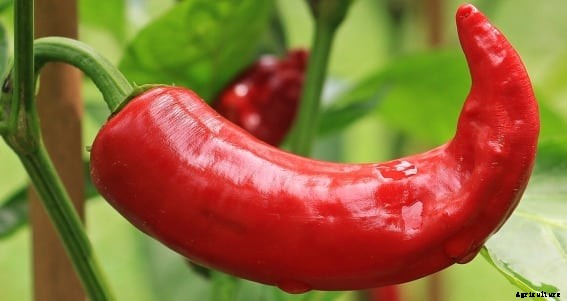 Red Chilli.
Red Chilli.
CELERY SPICE FARMING:
- INTRODUCTION: The binomial name of celery is apium graveolens. It is an herb used for various purposes. The height of the herb is 10-14 inches and has white colored flowers. It is a native of the Mediterranean region.
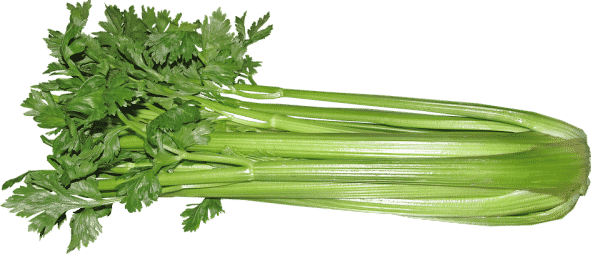 Celery.
Celery. - SOIL AND CLIMATE CONDITIONS FOR CELERY SPICE FARMING: During the growing stage it needs cold climate and during maturing it needs warm climate. A well drained loamy soil is considered good for this herb. The min temperature requirements are 12-30 degree Celsius with an average rainfall of 100 cm. The pH of the soil is maintained at 5.6 for good produce.
- PROPAGATION: propagation is done using seeds which are initially raised in a nursery and then transplanted to the main area.
- LAND PREPARATION AND PLANTING: Land is ploughed four to five times before planting. The spacing of these celery plants is 45 cm x 25 cm and the sowing depth is 2-4 cm. The seeds take 4-8 weeks for seedling and after 2 months, transplanted to the main area. November is the best time for sowing seeds.
- MANURING AND IRRIGATION: FYM @ 20-25 tonnes are used along with nitrogen @200 kg, phosphorous @100 kg and potash @150 kg per hectare is required. Irrigation is highly essential and is given at an interval of 10-15 days.
- DISEASE MANAGEMENT: Damping –off, Fusarium yellows, early blight downy mildew is controlled by drenching the land with 400 grams of copper Oxy chloride 。
- HARVESTING AND PROCESSING: 4-5 months after sowing, the crops are harvested.
- YIELD: one hectare of land yields about 25-30 tonnes of celery.
CUMIN SPICE FARMING:
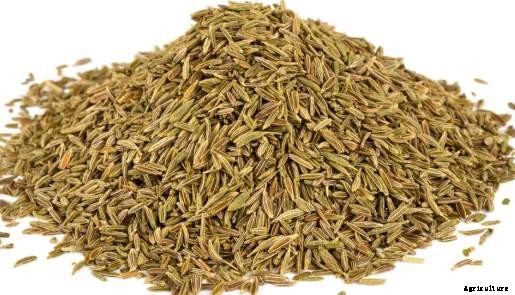 Cumin Seeds.
Cumin Seeds. - INTRODUCTION: This is a flowering plant and native to the Middle East and India. Its binomial name is Cuminium Cyminum. Cumin is a herbaceous plant whose seeds is dried and used as spice. The height of this plant is 30-50cm. In Hindi it is addressed as jeera which is most famous and widely used spice in Indian cuisines.
- SOIL AND CLIMATE CONDITIONS FOR CUMIN SPICE FARMING: Sandy loam soil with high nutrient content is required for the cultivation of cumin. The soil should be well drained and should be able to hold moisture. Mild climate is required for its cultivation and winter weather is also suitable. Sunlight is highly essential for its growth.
- PROPAGATION: seeds are used for propagation.
- LAND PREPARATION AND PLANTING: sowing of cumin seeds is done in December and the rows are spaced 30 cm apart.
- MANURING AND IRRIGATION: FYM @ 12-15 tonnes/ha along with phosphorus @20 kg, nitrogen @30 kg is applied to the soil. These fertilizers are applied in two splits. Initially the seedlings are lightly watered and the second irrigation is done after 7-10 days.
- DISEASE MANAGEMENT: Powdery mildew is controlled by spraying 20-25 grams /10 liters of water.同様に、 Alternaria blight is controlled by spraying 0.2% of dinocap.
- HARVESTING AND PROCESSING: Complete maturity in plants is obtained within 100-115 days from sowing. Harvesting is done by uprooting the entire plant and drying it. The dried plants are thrashed to remove seeds.
- YIELD: An average yield is 5 quintals per hectare.
GINGER SPICE FARMING:
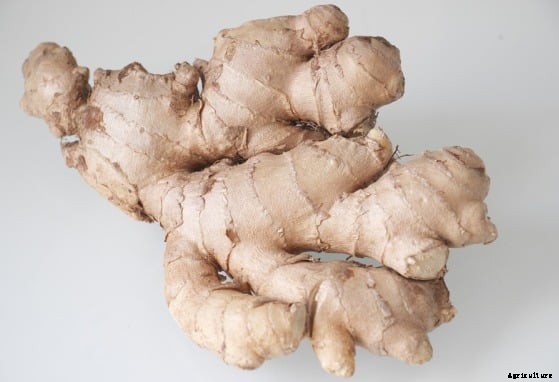 Ginger root.
Ginger root. - INTRODUCTION: This spice is native to Asia and has high demand locally and internationally. It is an herb which grows to a height of 1 m and bears yellow flowers. This spice has many medicinal properties and refreshing aroma.
- SOIL AND CLIMATE CONDITIONS FOR GINGER SPICE FARMING: Warm, humid climate is favorable for the growth of ginger. An altitude of 1400-1500 m is suitable for cultivation. This herb is grown in different soils. The pH of the soil should be 5-6.5.
- PROPAGATION: Propagation is done using rhizomes. The length of the rhizome should be 5-5 cm and should weight 20-25 grams 。
- LAND PREPARATION AND PLANTING: 3-4 ploughings of land are done during summer. Crosswise harrowing is done to make the soil loose. A bed for the crops is made 1 m wide, 15 cm high 。 Each bed is separated by 50 cm. solarisation is done using polyethylene sheets for 40-45 days.
- MANURING AND IRRIGATION: FYM @ 15 tonnes/ha along with NPK @60 kg, 50 kg, 50 kg / ha respectively is used for growing these crops. Irrigation is provided at an interval of 8-10 days. Maximum 20 irrigation cycles are needed for the entire growing period. Drip irrigation is also preferred.
- DISEASE MANAGEMENT: Shoot borer is controlled by spraying 0.1% of Malathion. Rhizome flies are controlled by spraying 05% methyl parathion 。 Leaf roller and scales are controlled by spraying 0.05% dimethoate 。 Soft rot is controlled by captafol 0.1%. Leaf spot is controlled by a 1 % Bordeaux mixture 。 Root knot nematode is controlled by solarising. Bacterial wilt is controlled by spraying 200 ppm streptocycline 。
- HARVESTING AND PROCESSING: Green ginger can be harvested in 215-220 days after planting the rhizomes. Yellowing of leaves indicates the harvesting season.
- YIELD: One hectare of land produces 10-15 tonnes of green ginger.
THYME SPICE FARMING:
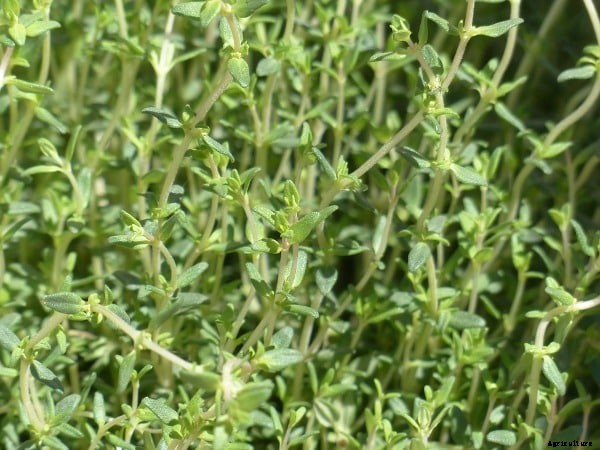 Thyme herb.
Thyme herb. - INTRODUCTION: This is an evergreen herb with aroma, generally used for cooking and medicinal purposes. It originated from the Europe and spread throughout the world through Romans.
- SOIL AND CLIMATE CONDITIONS FOR THYME SPICE FARMING: Requires well drained, fertile soil. Warm climate is suited for thyme plants and hill regions are considered best for cultivation.
- PROPAGATION: It is propagated through seeds and also vegetatively by plants.
- LAND PREPARATION AND PLANTING: ploughing is highly essential to prepare the land and plants are planted 15-30 cm apart. The spacing between the rows is 60 cm.
- MANURING AND IRRIGATION: FYM @ 50 tonnes/ha, vermicompost @ 5 tonnes/ha, neem cake @1.25 kg/ha, azospirillum and phosphobacterium and panchagavya is sprayed @3%.
- DISEASE MANAGEMENT: No major diseases occur to this plant.
- HARVESTING AND PROCESSING: For cooking purposes leaves and flowers are used. Harvesting starts from 4-5 months of sowing. The shoots are cut from the plant with a length of 15 cm. When the leaves dry, they curl and turn brown.
- YIELD: one hectare of land yield 1100-2200 kg of thyme.
CLOVE SPICE FARMING:
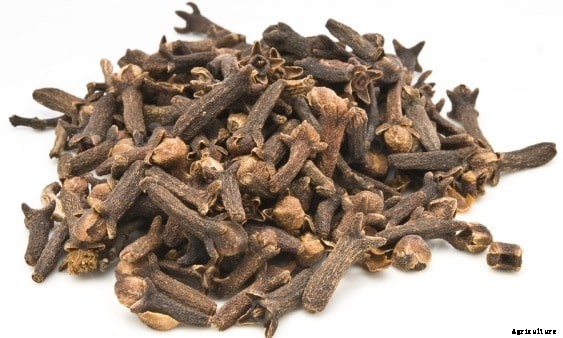 Cloves.
Cloves. - INTRODUCTION: Clove is an evergreen tree with high medicinal properties. The binomial name is Eugenia caryophyllus and is native to the Indonesian island. This plant grows to a height of 7-15 m. The dry unopened flower bud of the plant is the clove. In India the Western Ghats are popular for clove cultivation.
- SOIL AND CLIMATE CONDITIONS FOR CLOVE SPICE FARMING: This plant requires a warm, humid climate of temperature 20-30 degree Celsius and an average rainfall of 150-250 cm 。 The altitude is generally estimated to be 1500 m above mean sea level. Black loamy soil with rich humus is well suited for clove cultivation. Sometimes it is also grown in clay loam and laterite soil.
- PROPAGATION: Seeds are used for the propagation of clove usually during June to October. The seeds are soaked in water before sowing.
- LAND PREPARATION AND PLANTING: Pits of dimensions 60 cm x 75 cm x 3 cm are dug with a spacing of 6-7 m and filled with topsoil. Planting of seeds is done at the end of the monsoon.
- MANURING AND IRRIGATION: Rotten cattle manure @15 kg is required initially, but as the plants grow, they need more manure. The manure is applied basally at a radius of 5メートル from the tree. Pot watering is required if there is no sufficient water supply. Plants need subsoil irrigation during peak summer season.
- DISEASE MANAGEMENT:
- HARVESTING AND PROCESSING: yielding starts during 7 years, but to attain full bearing the tree takes 15-20 years 。 After flowering the buds take 4-6 months for harvesting. The buds are dried for 4-5 days.
- YIELD: One fully grown tree gives 4-8 kg of dried buds.
FENNEL SPICE FARMING:
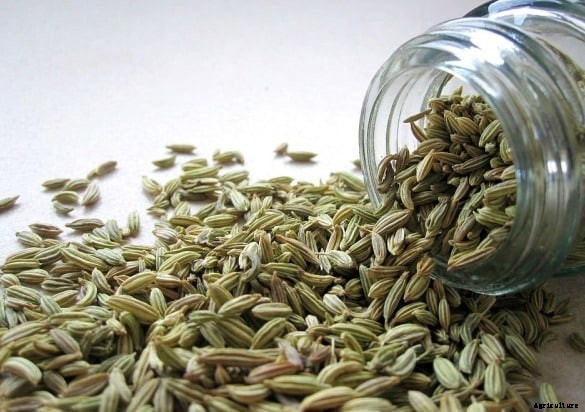 Fennel.
Fennel. - INTRODUCTION: It is a flowering plant and native to the Mediterranean. This spice has an exclusive aroma and a different flavor. This herbaceous plant grows to a height of 2.5 m. The binomial name is Foeniculum Vulgare. In India it is addressed as Saunf in Hindi.
- SOIL AND CLIMATE CONDITIONS: Every kind of soil is suitable for the cultivation of fennel. But well drained sandy or loamy soil is best suited with a pH of 6.5-8. The optimum temperature for the cultivation of these crops is 15-25 degree Celsius with an average rainfall of 50-75mm 。
- PROPAGATION: It is not a transplanting variety. Propagation is done through seeds directly sowed in the main area.
- LAND PREPARATION AND PLANTING: The land is ploughed two three times to prepare a fine seed bed. This plant is rarely raised in nurseries. Sowing is done during October and if it is a rain fed region, then spacing of 45 cm between rows with 10 cm crop spacing is maintained.
- MANURING AND IRRIGATION: Cow dung@4-6qtl/acre along with urea@45 kg/acre i s applied three times in equally split proportions. Pre-sowing irrigation is done and then at an interval of 10-15 days 10-12 cycles of irrigation is required during the entire duration of cropping.
- DISEASE MANAGEMENT: Aphids are controlled by spraying 0.03% of dimethoate 。 Seed midge and heliothis is controlled by spraying 0.07% of endosulphan 。
- HARVESTING AND PROCESSING: Maturity of plants is known when seeds are full and green in color. The umbels are cut and dried in the sun for 2 days and then dried in the shade for 10 days. The crop harvesting is done in May i.e. after 180 days from sowing.
- YIELD:O ne hectare of land yields 10-11 quintals of fennel on an average.
BLACK PEPPER SPICE FARMING:
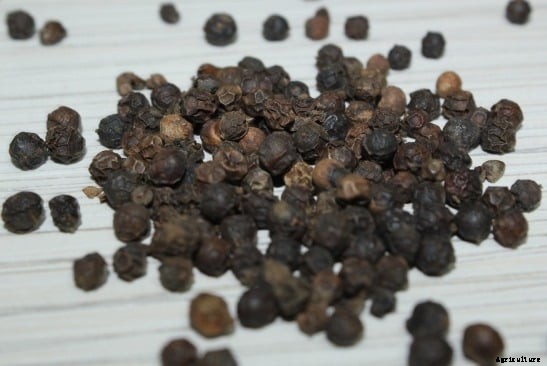 Black Pepper.
Black Pepper. - INTRODUCTION: The binomial name of black pepper is ‘piper nigrum’ and it is an evergreen flowering vine. This plant in mostly found in south India and grows to a height of 10 m. This is the earliest form of spice in India. There are 75 cultivars of pepper in India of which Karimunda is most popular. Other varieties are kottanadan, narayakkodi, aimpiriyan, kuthiravally, balancotta, kalluvally, malligesara and uddagare.
- SOIL AND CLIMATE CONDITIONS FOR BLACK PEPPER SPICE FARMING: pepper plants require tropical humid climate with sufficient rainfall (125-200 cm). The submountaeous region of Western Ghats is exclusive for growth of pepper plants. Clay loam, red loam and lateritic soils are suitable for pepper farming. The pH value of the soil is maintained at 4.5-6.0. The temperature should be in between 10-40 degree Celsius.
- PROPAGATION: Cutting from runner shoots is used for propagation of pepper. One third of the root is cut and planted in the nursery. They are obtained in the month of February –March. Roots develop from the cuttings and they are set for planting.
- LAND PREPARATION AND PLANTING: level land with proper drainage is chosen for farming. South facing slopes are avoided, but north or north eastern slopes are preferred to avoid the effect of the sun. Planting is done in the monsoon. Square pits of dimensions 0.5 m x 0.5 m are dug and the spacing between the pits is 2.5 m x 2.5 m 。 Seedlings which are two years old are planted in the pits. When the vine grows, it is initially made to creep on a pole of 2 m height. After a certain length the temporary stake is removed and planted in a trench of depth and width equal to 15 cm close to the tree trunk.
- MANURING AND IRRIGATION: Rotten cattle manure@ 10 kg is used as manure for pepper plants. 100 grams of nitrogen, 40 grams of P2O5 and 140 grams of K2O is used as a fertilizer for three year old plants. 1/3
rd
of the above mentioned composition is applied in the first year and 2/3rd of the quantity is applied in the second year. Lime @500 grams is applied as fertilizer during later stages of development.
- HARVESTING AND PROCESSING: Yield starts after 3 or 4 years from planting. The ripening takes 6-8 months from flowering and harvesting is done during November till February. The entire spike is plucked when the berries turn bright red. The spike is rubbed with hands to remove the berries which are then dried in the sun for 7 to 10 days until the berries turn black.
- YIELD: 800-1000 kg of black pepper is obtained from one hectare of plantation land (7-8 yrs old). The yield reduces after every 20-25 years.
CINNAMON SPICE FARMING:
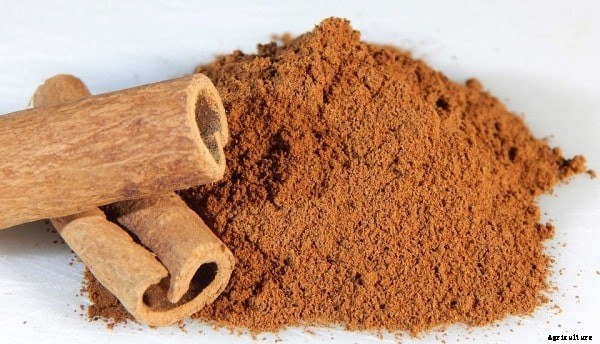 Cinnamon spice.
Cinnamon spice. - INTRODUCTION: Cinnamon is the inner bark of the tree and is the first known spice with rich flavour. It is native to Sri Lanka. Also lower slopes of Western Ghats (Kerala and Tamilnadu) cinnamon cultivation are predominant. Binomial name is Cinnamomum Cassia.
- SOIL AND CLIMATE CONDITIONS FOR CINNAMON SPICE FARMING: lateritic and sandy soil is preferred for cinnamon plant. The elevation of land above sea level is approximately 1000 m 。 This plant requires an annual rainfall of 200-250 cm 。
- PROPAGATION :Cinnamon is propagated by rooted cuttings, air layering and seeds. 10 cm long with 2 leaves semi hardwood cuttings are dipped in keradix-B and planted in a polythene bag consisting of sand and coir dust mixture in the ratio 1:1. These are watered twice in a day and stored in the shade.後 45-60 days the roots develop indicating that it can be transplanted to a another permanent place
- A ring from the semi hardwood bark is removed and IBA 2000 ppm is applied on it. This region is covered with coir husk and wrapped with 20 cm of polythene. Rooting starts after 40-60 days and the air layers are detached from the parent plant. These can be planted in the main area during monsoon
- For the sowing of seeds a mixture of sand, soil and rotten cattle manure in the ratio 3:3:1 is prepared and germination starts after 15 -20 days. Moisture is a must for these plants.
- LAND PREPARATION AND PLANTING: Pits of dimensions 50 cm x 50 cm x 50 cm are dug with space between each pit being 3m x 3m. The pit is initially filled with topsoil and compost and the seedling are planted. One acre land can accommodate 3600 pits
- MANURING AND IRRIGATION: 20 grams of nitrogen, 18 grams of P2O5 and 25 grams of K2O are used as fertilizer in the initial growth period. The dose increases with the age of the plants. Fertilizers are applied during may-June and September-October. Green leaves are used for mulching FYM @25 kg i s applied in May-June. Irrigation is essential during summer.
- DISEASE MANAGEMENT: Colletotrichum Gloeosporioides causes leaf spotting and die back disease. Diplodia sp. causes seedling blight. Pestalotia palmarum causes grey blight. All these are controlled by a 1 % Bordeaux mixture 。 Pests like leaf minor and cinnamon butterfly are controlled by the use of quinalphos (0.05%).
- HARVESTING AND PROCESSING: When the tree is grown to a height of 10-15 m in 4 years, shoots are available for peeling. Coppicing is done to encourage regrowth. Shoots of thickness 5-2 cm are chosen for the extraction of barks. 1-1.25 m of shoots are cut into straight pieces followed by scraping and peeling. The peels are dried in the shade and then in sunlight for 4 days. Dried barks take the shape of a quill. Grading of quills is done from 00000, 0 being the most coarse quality. Small bark pieces are called quillings; thin inner pieces are called featherings.
- Distillation of dried cinnamon leaves and barks produces oils. This oil is used in soaps, perfumes, クリーム、 toothpastes etc.
- CULTIVARS AND YIELD: Two varieties are known in India, the Navashree and the Nithyashree. 56 and 54 kg of dry quills /ha /yr are obtained from Navashree and Nithyashree respectively. The product yield of Navashree is such that 2.7% bark oil, 73% cinnamaldehyde 8% oleoresin 2.8% leaf oil, 62% leaf eugenol. The product yield of Nithyashree is (2.7% bark oil, 58% cinnamaldehyde, 10% oleoresin, 3% leaf oil and 78% eugenol.
Read about Zero Budget Natural Farming.
Read about Hydroponic Growing System.



















